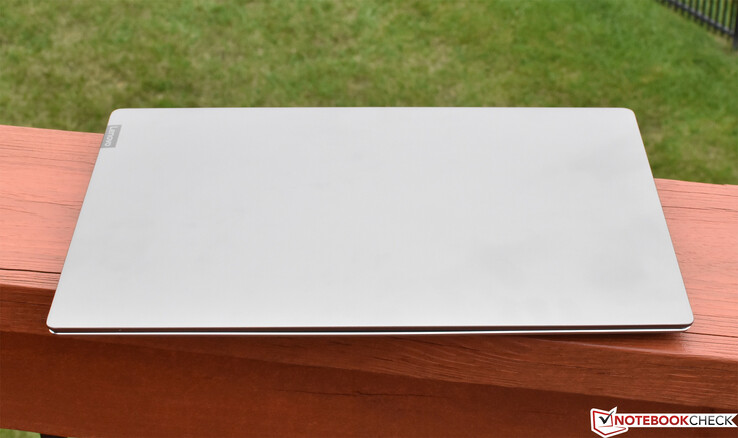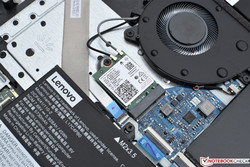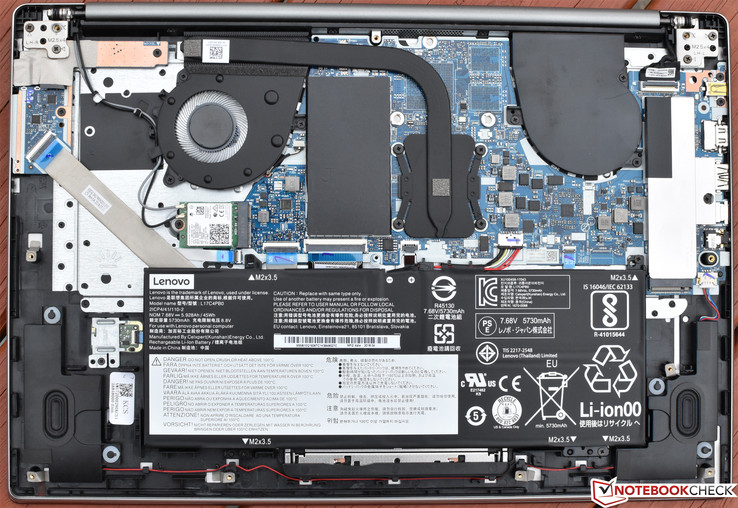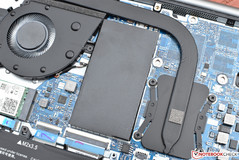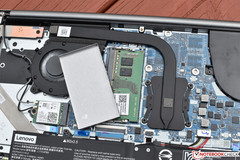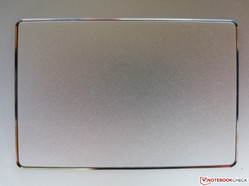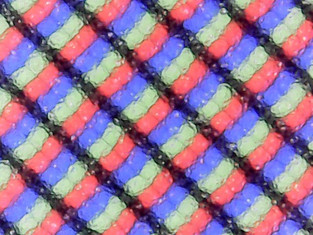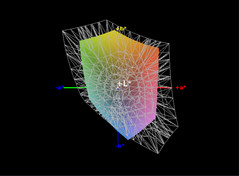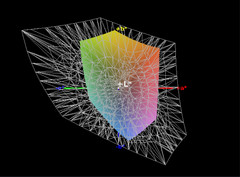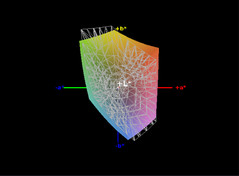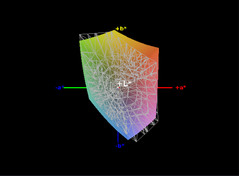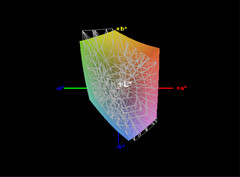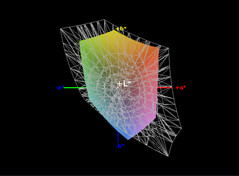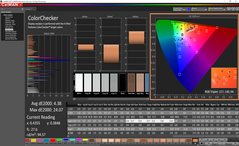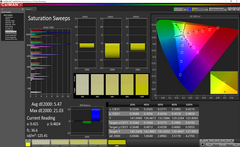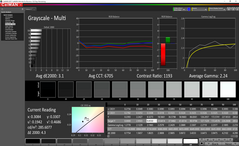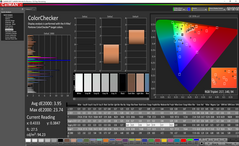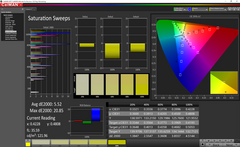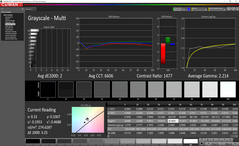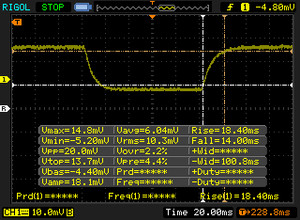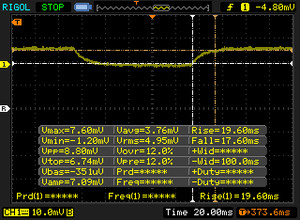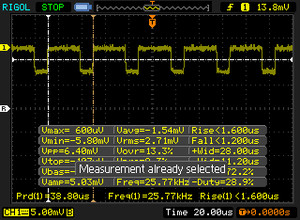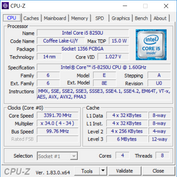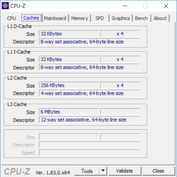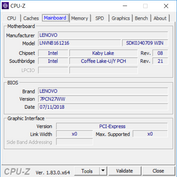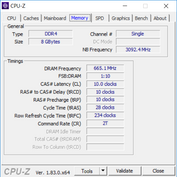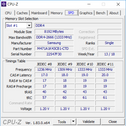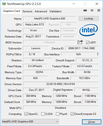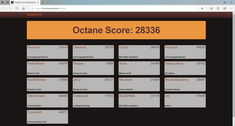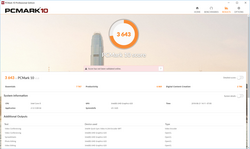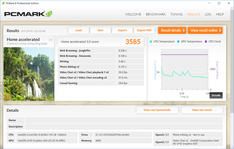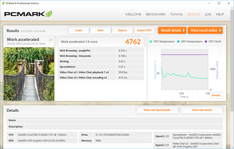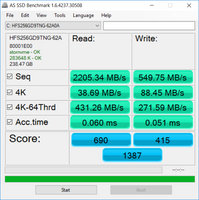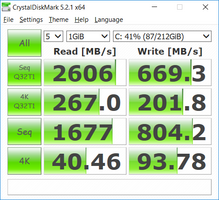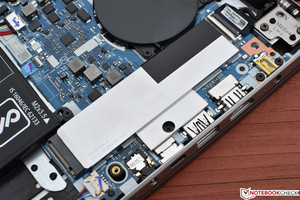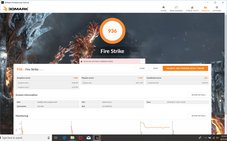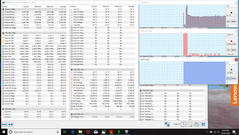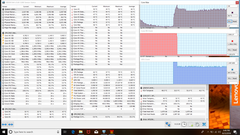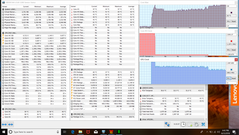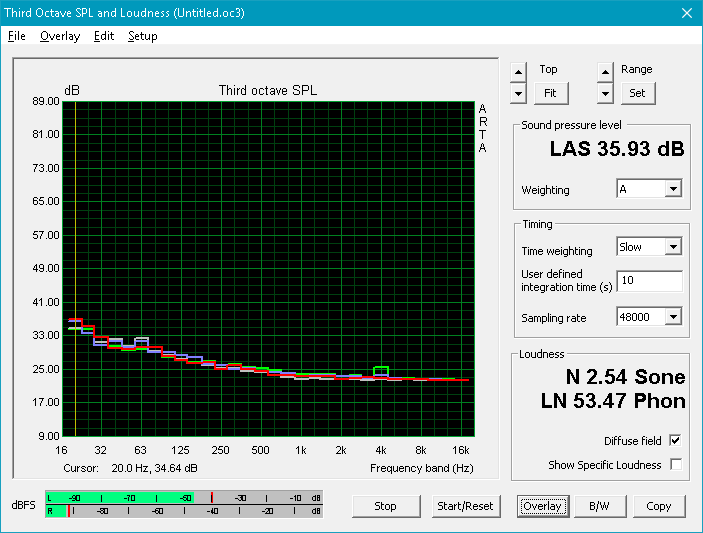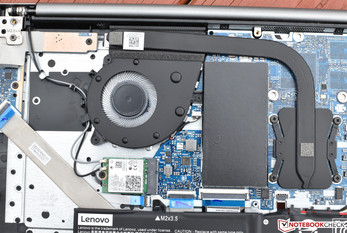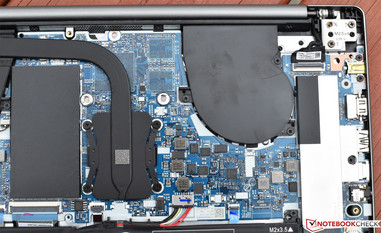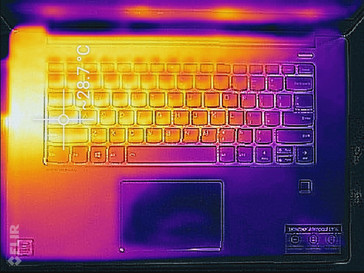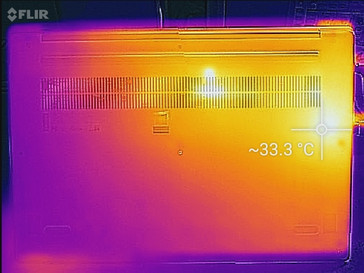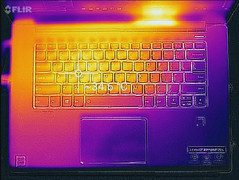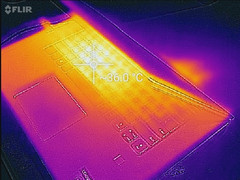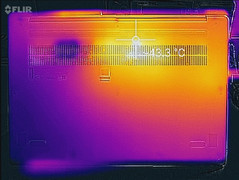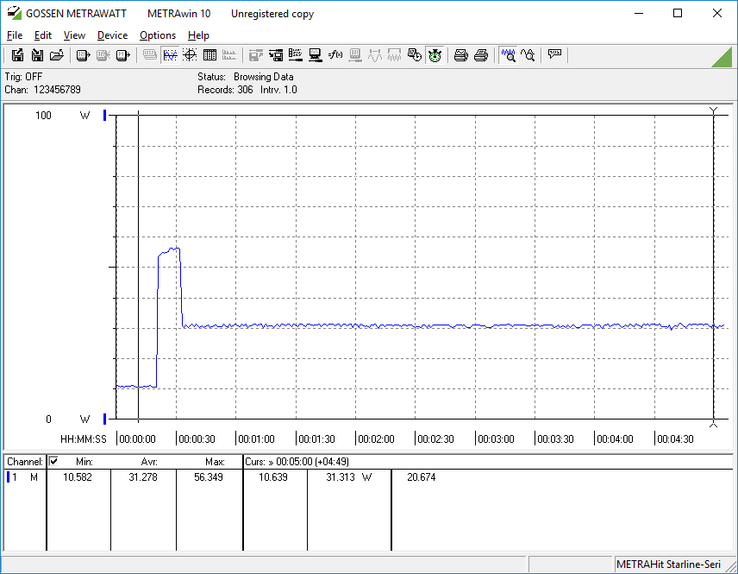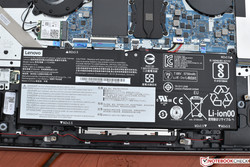Lenovo Ideapad 530S-15IKB (i5-8250U, FHD) Laptop Review

Although we never had a chance to personally review the 15-inch IdeaPad 520S, its thin-and-light, pseudo-premium design carried hints of attributes that one would normally associate with much pricier laptops such as Dell’s XPS 15. Now, with the revised IdeaPad 530S, Lenovo takes this strategy further and punches up against such heralded ultra-high-end rivals with an even slimmer case, beautiful aesthetics (spearheaded by its XPS-like thin bezels and aluminum casing), and thoroughly capable components.
While configurations with discrete graphics are available, our review unit is powered by the typical Intel UHD Graphics 620 alongside an Intel Core i5-8250U SoC, 8 GB RAM, and a 256 GB NVMe SSD. But the real shocker is the price: just $699 MSRP, which is perhaps 30% less than one might reasonably expect to pay for a comparably-equipped XPS 15. That’s surely impressive, but can the IdeaPad’s performance in our exhaustive evaluation match the splendor of its spec sheet? Without further ado, let’s dive in and find out.
Case
Fully adorned in silver aluminum casing, the IdeaPad 530S visually impresses from the outset. With its carefully CNC machined edges and rounded corners, the precision of the construction and general build quality leave little for criticism. The sole bit of plastic is found flanking the display, where the black slim bezel adheres to the panel (again, a la XPS) for a consistent look throughout the entire perimeter. Surely conscious of the quibbles surrounding webcam placement on competing models, Lenovo has opted for a slightly larger top bezel to accommodate the tiny webcam in its normal location.
While appearances are one thing, the quality differential between the IdeaPad and higher-end competitors such as the Dell XPS 15 and MacBook Pro does begin to expose itself once pressure is applied to the surfaces. Though certainly durable enough for everyday use (and stronger than most budget competitors to boot—twisting the base produces no notable creaking), the thinness of the aluminum casing is evident, manifesting in the form of detectable flex under moderate pressure across the breadth of the base unit. Likewise, the display lid isn’t nearly as rigid as that of the XPS, though it still manages reasonably good torsion resistance and protection against pressure from behind. Alas, these are the necessary sacrifices one must make in order to reach such a stunningly affordable price tag while still maintaining such an attractive design and capable components.
In comparison to its predecessor, the weight and size of the IdeaPad 530S have both been reduced slightly (it’s now just 1.676 kg with a footprint only slightly larger than the XPS 15). Although some other trade-offs apply (as we’ll see in the connectivity section below), for the most part, this is a positive move. The central drop-back hinge design is well-tuned to suppress unwanted bounce due to vibration, but as is usually the case with such machines, two hands are required to open the display. Some users dislike this design due to the fact that wide opening angles result in the hinge lifting the machine off the surface slightly, but it’s becoming increasingly widespread as devices continue to slim down further.
Connectivity
The IdeaPad 530S features a decent selection of ports, but it has suffered a bit as a result of its diet. Specifically, it’s lost the Ethernet port, and unfortunately, while three total USB ports are still onboard (one of which is Type-C Gen 1), there are no options for Thunderbolt connectivity. Otherwise, however, the IdeaPad matches the XPS 15 in terms of port selection, and it tramples over the ASUS VivoBook (with its ancient USB 2.0 ports). The larger HP Pavilion 15 still includes the Ethernet port in addition to the rest, however, and the HP Spectre 15 outdoes all of the competitors with not one but two Thunderbolt ports.
Port placement is convenient, lining the left and right edges of the machine exclusively. This is unsurprising due to the central drop-back hinge design obscuring the rear of the machine while in use. However, the ports on the left side have been crammed a bit closer together than is convenient; larger connectors will block adjacent ports in some cases.
SD Card Reader
Perhaps both the XPS 15 and IdeaPad 530S include identically-sized SD card readers, but performance couldn’t be further apart. In our JPG copy and AS SSD read tests, the IdeaPad is basically dead last with a pitiful 27.35 MB/s and 28.95 MB/s in each test—some 350% and 590% below the speeds of the XPS (which leads), respectively, and far below the class average.
The SD slot does not fully accept the card; roughly half of the SD card sticks out of the port during use.
| SD Card Reader | |
| average JPG Copy Test (av. of 3 runs) | |
| Dell XPS 15 2018 i5 FHD 97Wh | |
| Average of class Multimedia (21.1 - 198, n=41, last 2 years) | |
| Acer Aspire 3 A315-41-R7BM (Toshiba Exceria Pro SDXC 64 GB UHS-II) | |
| Asus VivoBook 15 X570UD (Toshiba Exceria Pro M501 UHS-II) | |
| HP Pavilion 15-cs0053cl (Toshiba Exceria Pro SDXC 64 GB UHS-II) | |
| Lenovo Ideapad 530S-15IKB (Toshiba Exceria Pro SDXC 64 GB UHS-II) | |
| Dell Inspiron 15 5579-9672 (Toshiba Exceria Pro SDXC 64 GB UHS-II) | |
| maximum AS SSD Seq Read Test (1GB) | |
| Dell XPS 15 2018 i5 FHD 97Wh | |
| Average of class Multimedia (27.4 - 262, n=41, last 2 years) | |
| Acer Aspire 3 A315-41-R7BM (Toshiba Exceria Pro SDXC 64 GB UHS-II) | |
| Asus VivoBook 15 X570UD (Toshiba Exceria Pro M501 UHS-II) | |
| HP Pavilion 15-cs0053cl (Toshiba Exceria Pro SDXC 64 GB UHS-II) | |
| Dell Inspiron 15 5579-9672 (Toshiba Exceria Pro SDXC 64 GB UHS-II) | |
| Lenovo Ideapad 530S-15IKB (Toshiba Exceria Pro SDXC 64 GB UHS-II) | |
Communication
Accessories
A compact 65 W AC Adapter (sans the sometimes-inconvenient ground plug) is packed in with the IdeaPad 530S. It’s relatively light at just 214 g, but its consolidated design also means that it can block adjacent outlets in some cases.
Maintenance
Thanks to a removable bottom panel, maintenance on the IdeaPad 530S is relatively easy. Ten Torx T5 screws secure the cover, after which some light prying around the perimeter quickly dislodges it. Once inside, the battery, WLAN adapter, M.2 SSD, heatsink/fan, and speakers are simple to replace. The RAM can also be upgraded/replaced, but due to its location beneath a thin metal shield, it’s difficult to reach without damaging the shield during the removal/reinstallation process. As is usually the case with most modern thin-and-light laptops, the keyboard is among the hardest parts to service; not only is it beneath the board, but it’s also attached to the top cover via numerous plastic spot welds, essentially making it impossible to replace.
Warranty
The IdeaPad 530S ships with a 1 year depot warranty.
Input Devices
Keyboard
The IdeaPad 530S’ keys feature short travel with medium actuation force, but feedback is relatively sharp, which led to a relatively short adjustment period before we felt comfortable typing on it at higher speeds. Spacing and layout is good as well, though the fact that the grey keys are labeled in white makes visibility a bit tougher than it should be in certain conditions. Despite its relative proficiency, the IdeaPad keyboard is still a ways off from the best Ultrabook keyboards in this class, such as that of the HP Spectre and Dell XPS 15.
Unlike some other 15.6-inch machines, the IdeaPad makes no room for a numeric keypad. The keys are evenly backlit with two stages of brightness (in addition to off).
Touchpad
The sufficiently large 105 x 70 mm clickpad features a smooth, comfortable Mylar finish with fast response speeds, little to no cursor delay, and seamless gesture interpretation (the Precision drivers are largely to thank for this, of course). The integrated buttons are decent, with hardly any collateral pointer movement during clicks and good interpretation of left/right button operation, but like the keyboard, they’re a grade below those of the XPS and Spectre devices, and of course, nothing works quite as well as separate dedicated buttons.
Display
Only a single display options exists on the 15.6-inch IdeaPad 530S, and it’s a typical FHD IPS panel—not that we’re complaining about that. It’s also fortunately anti-glare (though no touch options exist either), and although Lenovo quotes the brightness at 250 cd/m², our initial impressions were that it must be a bit higher than that. The contrast also subjectively appears to be good, and colors don’t have much pop to them, but they’re not wildly deviant to the eye, either. Unlike many matte displays, we don’t detect any untoward graininess resulting from the anti-glare finish on the 530S panel.
| |||||||||||||||||||||||||
Brightness Distribution: 88 %
Center on Battery: 285.1 cd/m²
Contrast: 1018:1 (Black: 0.28 cd/m²)
ΔE ColorChecker Calman: 4.38 | ∀{0.5-29.43 Ø4.78}
calibrated: 3.95
ΔE Greyscale Calman: 3.1 | ∀{0.09-98 Ø5}
62% sRGB (Argyll 1.6.3 3D)
40% AdobeRGB 1998 (Argyll 1.6.3 3D)
43.32% AdobeRGB 1998 (Argyll 3D)
62.4% sRGB (Argyll 3D)
41.84% Display P3 (Argyll 3D)
Gamma: 2.24
CCT: 6705 K
| Lenovo Ideapad 530S-15IKB N156HCA-EAB, IPS, 15.6", 1920x1080 | HP Pavilion 15-cs0053cl AU Optronics B156XW02 V0, TN LED, 15.6", 1366x768 | Asus VivoBook 15 X570UD AU Optronics B156HAN06.1, IPS, 15.6", 1920x1080 | Dell Inspiron 15 5579-9672 AUO, B156HW01, IPS, 15.6", 1920x1080 | Acer Aspire 3 A315-41-R7BM Chi Mei CMN15D5, TN LED, 15.6", 1920x1080 | Dell XPS 15 2018 i5 FHD 97Wh Sharp SHP149A LQ156M1, LED IGZO IPS InfinityEdge, 15.6", 1920x1080 | |
|---|---|---|---|---|---|---|
| Display | -8% | -8% | -12% | -4% | 56% | |
| Display P3 Coverage (%) | 41.84 | 38.37 -8% | 38.66 -8% | 37 -12% | 40.09 -4% | 66 58% |
| sRGB Coverage (%) | 62.4 | 57.7 -8% | 57.9 -7% | 55.6 -11% | 59.7 -4% | 96.5 55% |
| AdobeRGB 1998 Coverage (%) | 43.32 | 39.65 -8% | 39.94 -8% | 38.23 -12% | 41.47 -4% | 66.7 54% |
| Response Times | 18% | 12% | 0% | 20% | -13% | |
| Response Time Grey 50% / Grey 80% * (ms) | 37.2 ? | 43.6 ? -17% | 32 ? 14% | 41 ? -10% | 44 ? -18% | 49 ? -32% |
| Response Time Black / White * (ms) | 32.4 ? | 15.2 ? 53% | 29.2 ? 10% | 29 ? 10% | 14 ? 57% | 30 ? 7% |
| PWM Frequency (Hz) | 25770 ? | 25000 ? | 961 ? | |||
| Screen | -49% | 2% | 3% | -56% | 37% | |
| Brightness middle (cd/m²) | 285.1 | 220.1 -23% | 240.1 -16% | 251 -12% | 234 -18% | 413 45% |
| Brightness (cd/m²) | 271 | 210 -23% | 233 -14% | 240 -11% | 211 -22% | 378 39% |
| Brightness Distribution (%) | 88 | 93 6% | 91 3% | 84 -5% | 83 -6% | 86 -2% |
| Black Level * (cd/m²) | 0.28 | 0.29 -4% | 0.23 18% | 0.2 29% | 0.43 -54% | 0.29 -4% |
| Contrast (:1) | 1018 | 759 -25% | 1044 3% | 1255 23% | 544 -47% | 1424 40% |
| Colorchecker dE 2000 * | 4.38 | 11.4 -160% | 4.25 3% | 5.25 -20% | 11.27 -157% | 2.44 44% |
| Colorchecker dE 2000 max. * | 24.07 | 25.96 -8% | 17.84 26% | 10.04 58% | 18.03 25% | 4.46 81% |
| Colorchecker dE 2000 calibrated * | 3.95 | 4.09 -4% | 4 -1% | 2.48 37% | ||
| Greyscale dE 2000 * | 3.1 | 12 -287% | 2.8 10% | 3.28 -6% | 11.54 -272% | 2.48 20% |
| Gamma | 2.24 98% | 2.09 105% | 2.3 96% | 2.15 102% | 2.09 105% | 2.43 91% |
| CCT | 6705 97% | 12625 51% | 6503 100% | 6502 100% | 11607 56% | 7006 93% |
| Color Space (Percent of AdobeRGB 1998) (%) | 40 | 36.5 -9% | 36.8 -8% | 35 -12% | 38 -5% | 62 55% |
| Color Space (Percent of sRGB) (%) | 62 | 57.5 -7% | 57.8 -7% | 55 -11% | 60 -3% | 96 55% |
| Total Average (Program / Settings) | -13% /
-33% | 2% /
1% | -3% /
-0% | -13% /
-35% | 27% /
35% |
* ... smaller is better
Sure enough, we measure an average brightness of 271 cd/m² with a contrast ratio of 1018:1 (against a black value of 0.28 cd/m²). Distribution is reasonably good at 88%, which represents fairly uniform luminosity across the panel.
Color coverage is decent, but not far above the rest of the pack: we record 62% of sRGB and 40% of AdobeRGB. When compared to nicer panels such as the XPS 15’s FHD display (96% / 62%), these values pale in comparison—but in context with the price point and immediate competitors within that range it’s actually not a bad result. Just don’t expect color-accurate graphic design or ideal photo editing capabilities and you aren’t likely to be terribly disappointed. There’s a bit of a washed-out appearance to the color, but it’s nothing quite as dreary as what we noted with the ThinkPad T480, for instance.
As for color rendering accuracy, the IdeaPad once again manages a decent showing. The HP Pavilion 15 and Acer Aspire 3 are the clear laggards here, but the rest of the pack (including the IdeaPad) fares much better; the 530S manages 4.38 / 3.1 out of the box (uncalibrated) in these same two measurements, though Blue is heavily deviant at 24.07. Elsewhere, the Total Gamma of 2.24 and CCT Average of 6705 are not far from their ideal values.
Display Response Times
| ↔ Response Time Black to White | ||
|---|---|---|
| 32.4 ms ... rise ↗ and fall ↘ combined | ↗ 18.4 ms rise | |
| ↘ 14 ms fall | ||
| The screen shows slow response rates in our tests and will be unsatisfactory for gamers. In comparison, all tested devices range from 0.1 (minimum) to 240 (maximum) ms. » 87 % of all devices are better. This means that the measured response time is worse than the average of all tested devices (20.2 ms). | ||
| ↔ Response Time 50% Grey to 80% Grey | ||
| 37.2 ms ... rise ↗ and fall ↘ combined | ↗ 19.6 ms rise | |
| ↘ 17.6 ms fall | ||
| The screen shows slow response rates in our tests and will be unsatisfactory for gamers. In comparison, all tested devices range from 0.165 (minimum) to 636 (maximum) ms. » 53 % of all devices are better. This means that the measured response time is worse than the average of all tested devices (31.6 ms). | ||
Screen Flickering / PWM (Pulse-Width Modulation)
| Screen flickering / PWM detected | 25770 Hz | ≤ 67 % brightness setting | |
The display backlight flickers at 25770 Hz (worst case, e.g., utilizing PWM) Flickering detected at a brightness setting of 67 % and below. There should be no flickering or PWM above this brightness setting. The frequency of 25770 Hz is quite high, so most users sensitive to PWM should not notice any flickering. In comparison: 53 % of all tested devices do not use PWM to dim the display. If PWM was detected, an average of 8111 (minimum: 5 - maximum: 343500) Hz was measured. | |||
Response times are unsurprisingly rather slow, and though we do measure PWM (at all brightness levels below 67%), the high frequency of 25770 Hz means that most sensitive users will not likely find it bothersome. Outdoors, the display is usable mostly in shaded areas. Brighter environments can also be braved for shorter periods of time (and with careful screen positioning), but the display just isn’t bright enough for more than that (even in spite of its matte finish and good contrast). Viewing angles of the IPS panel are expectedly wide.
Performance
The IdeaPad 530S is configurable with three different Intel CPU options: Core i3-8130U, Core i5-8250U, and Core i7-8550U. It supports RAM up to 16 GB max (one total socket), and graphics options range from the Intel UHD Graphics (integrated) up to NVIDIA GeForce MX130 and GeForce MX150 configurations. Our review unit arrived with the i5-8250U CPU, 8 GB RAM, and integrated graphics. Again, for under $700, this is hardly a bad setup.
Operating unplugged inflicts no performance constraints on the machine; we record a 3DMark 11 score of 1787, which is actually above the original score we received (on AC power). LatencyMon reports no issues.
Processor
The Intel Core i5-8250U has been extensively covered in the past here at Notebookcheck; visit our dedicated page for an exhaustive look at it and its performance across a variety of machines. As for the IdeaPad 530S, its multi-core performance disappoints in comparison to the Core i5-8250U average of 570; with a score of just 490 in Cinebench R15 multi-CPU, it’s some 14% below the mark. Nevertheless, that’s still 12% above the Multimedia class average, and single-core performance isn’t affected (we received a score of 144 there versus 141 for the CPU average).
Unsurprisingly, the XPS 15 runs away with the crown here in the multi-core test (thanks to its much more power-hungry 45 W TDP Core i5-8300H). The IdeaPad, however, is in a distant fifth place. Only the Acer Aspire scores lower, with its AMD Ryzen 3 2200U CPU managing just 318 points.
In our Cinebench R15 multi-CPU sustained performance loop test, we see an initial score of 523 followed by an immediate drop down to the 490 range for the remainder of the test runs. That’s a retreat of around 6%, which isn’t bad at all considering that many machines suffer drops of 15% or 20% instead… though, to be fair, the initial score in this case wasn’t quite as impressive as that of many identically-equipped competitors.
System Performance
We experienced no troubling hiccups or slowdowns during our time with the IdeaPad 530S; the NVMe SSD and CPU seem quick enough to handle most tasks without any issues. Our synthetic scores offer further reassurance, landing within a couple of percentage points of the average for similarly-equipped machines—and while they’re obviously below the scores of the better-equipped XPS and VivoBook, it’s only by margins of 11% to 17%. For most users, the IdeaPad’s performance should not be an issue at all.
| PCMark 8 Home Score Accelerated v2 | 3585 points | |
| PCMark 8 Work Score Accelerated v2 | 4762 points | |
| PCMark 10 Score | 3643 points | |
Help | ||
Storage Devices
Our storage benchmarks clearly separate the NVMe from the SATA drives. Within that category, of course, further discrepancies exist; the XPS 15, for instance, only managed a Total Score of 750 in AS SSD versus 1387 from today’s 530S review unit. The Asus VivoBook actually takes top spot here with a Total Score of 2249 (thanks primarily to much faster 4K-64 read/write speeds than the IdeaPad), but in truth, the subjective difference is small indeed.
| Lenovo Ideapad 530S-15IKB SK hynix PC401 HFS256GD9TNG | Asus VivoBook 15 X570UD SK hynix PC300 HFS512GD9MND | Dell Inspiron 15 5579-9672 SK hynix SC311 SATA | Acer Aspire 3 A315-41-R7BM SK Hynix HFS256G39TND-N210A | Dell XPS 15 2018 i5 FHD 97Wh Lite-On CA3-8D256-Q11 | Average SK hynix PC401 HFS256GD9TNG | |
|---|---|---|---|---|---|---|
| AS SSD | 38% | -45% | -83% | -155% | -7% | |
| Copy Game MB/s (MB/s) | 301.1 | 792 163% | 231.6 -23% | 145.4 -52% | 465.9 55% | 423 ? 40% |
| Copy Program MB/s (MB/s) | 233.5 | 334.3 43% | 166.4 -29% | 94 -60% | 117.2 -50% | 358 ? 53% |
| Copy ISO MB/s (MB/s) | 868 | 1265 46% | 301.3 -65% | 199.8 -77% | 632 -27% | 748 ? -14% |
| Score Total (Points) | 1387 | 2249 62% | 910 -34% | 594 -57% | 750 -46% | 1423 ? 3% |
| Score Write (Points) | 415 | 836 101% | 330 -20% | 210 -49% | 58 -86% | 450 ? 8% |
| Score Read (Points) | 690 | 968 40% | 383 -44% | 256 -63% | 492 -29% | 679 ? -2% |
| Access Time Write * (ms) | 0.051 | 0.127 -149% | 0.075 -47% | 0.225 -341% | 0.889 -1643% | 0.1111 ? -118% |
| Access Time Read * (ms) | 0.06 | 0.059 2% | 0.142 -137% | 0.136 -127% | 0.086 -43% | 0.1118 ? -86% |
| 4K-64 Write (MB/s) | 271.6 | 677 149% | 247 -9% | 145 -47% | 19.19 -93% | 290 ? 7% |
| 4K-64 Read (MB/s) | 431.3 | 756 75% | 309.7 -28% | 187.9 -56% | 301.8 -30% | 452 ? 5% |
| 4K Write (MB/s) | 88.4 | 85.8 -3% | 47.64 -46% | 40.46 -54% | 5.12 -94% | 100.2 ? 13% |
| 4K Read (MB/s) | 38.69 | 30.78 -20% | 23.71 -39% | 22.24 -43% | 32.5 -16% | 38.9 ? 1% |
| Seq Write (MB/s) | 550 | 735 34% | 356.2 -35% | 241.8 -56% | 340.3 -38% | 593 ? 8% |
| Seq Read (MB/s) | 2205 | 1817 -18% | 497.5 -77% | 457.6 -79% | 1574 -29% | 1882 ? -15% |
* ... smaller is better
GPU Performance
To reiterate what we said in our Performance overview above, 530S configurations featuring NVIDIA dedicated MX130 and MX150 options do exist. However, our review unit is powered by the integrated Intel UHD Graphics 620 adapter instead, so obviously we should not expect strong graphical benchmarks. Indeed, the results we receive are actually roughly 7% to 14% below the averages for this adapter (and behind the identically-equipped HP Pavilion 15 by similar margins). An overall 3DMark 11 score of 1690 isn’t terrible by any means, but it’ll hardly play any modern games even at low settings—so if gaming has even a remote chance of appearing on the agenda, consider springing for one of the two dedicated graphics configurations instead.
| 3DMark 11 Performance | 1690 points | |
| 3DMark Cloud Gate Standard Score | 6844 points | |
| 3DMark Fire Strike Score | 936 points | |
Help | ||
| Rise of the Tomb Raider | |
| 1920x1080 Very High Preset AA:FX AF:16x (sort by value) | |
| Dell XPS 15 2018 i5 FHD 97Wh | |
| Average Intel UHD Graphics 620 (3 - 14.5, n=11) | |
| 1920x1080 High Preset AA:FX AF:4x (sort by value) | |
| Lenovo Ideapad 530S-15IKB | |
| Dell Inspiron 15 5579-9672 | |
| Acer Aspire 3 A315-41-R7BM | |
| Dell XPS 15 2018 i5 FHD 97Wh | |
| Average Intel UHD Graphics 620 (4.9 - 32, n=42) | |
| 1366x768 Medium Preset AF:2x (sort by value) | |
| Lenovo Ideapad 530S-15IKB | |
| HP Pavilion 15-cs0053cl | |
| Dell Inspiron 15 5579-9672 | |
| Acer Aspire 3 A315-41-R7BM | |
| Dell XPS 15 2018 i5 FHD 97Wh | |
| Average Intel UHD Graphics 620 (6.5 - 49.3, n=62) | |
| 1024x768 Lowest Preset (sort by value) | |
| Lenovo Ideapad 530S-15IKB | |
| HP Pavilion 15-cs0053cl | |
| Dell Inspiron 15 5579-9672 | |
| Acer Aspire 3 A315-41-R7BM | |
| Average Intel UHD Graphics 620 (10.4 - 110.7, n=82) | |
| Metro: Last Light | |
| 1920x1080 Very High (DX11) AF:16x (sort by value) | |
| Lenovo Ideapad 530S-15IKB | |
| Average Intel UHD Graphics 620 (6 - 8, n=3) | |
| 1366x768 High (DX11) AF:16x (sort by value) | |
| Lenovo Ideapad 530S-15IKB | |
| Average Intel UHD Graphics 620 (13 - 16, n=3) | |
| 1366x768 Medium (DX10) AF:4x (sort by value) | |
| Lenovo Ideapad 530S-15IKB | |
| HP Pavilion 15-cs0053cl | |
| Average Intel UHD Graphics 620 (16.4 - 28, n=4) | |
| 1024x768 Low (DX10) AF:4x (sort by value) | |
| Lenovo Ideapad 530S-15IKB | |
| HP Pavilion 15-cs0053cl | |
| Average Intel UHD Graphics 620 (23.3 - 41, n=5) | |
| low | med. | high | ultra | |
|---|---|---|---|---|
| BioShock Infinite (2013) | 47 | 21 | 19 | 7 |
| Metro: Last Light (2013) | 25 | 22 | 13 | 6 |
| Rise of the Tomb Raider (2016) | 17 | 11 | 6 |
Stress Test
Under synthetic CPU stress, for the first few seconds, the CPU maintains its full turbo clock rate of 3.4 GHz. Immediately thereafter, however, it drops (as expected) to 2.4 GHz, where it remains indefinitely. Temperatures are stable at just 64 °C, which is well below the point at which many competing notebooks begin to cap performance. This is surely a result of intrinsic headroom baked into the firmware to accommodate the more power-hungry SKUs featuring dedicated GPUs, but in our less demanding configuration, it merely results in unfortunately artificially limited CPU performance.
GPU stress results in an initial turbo frequency of 1100 MHz before leveling off permanently at a much lower 848 MHz; again, temperatures are held quite low at just 56 °C.
Combined CPU and GPU stress predictably lowers clock rates further, with the GPU managing just 698 MHz and CPU 1.2 GHz (the latter of which qualifies as throttling). Temperatures reach just 60 °C.
| CPU Clock (GHz) | GPU Clock (MHz) | Average CPU Temperature (°C) | Average GPU Temperature (°C) | |
| Prime95 Stress | 2.4 | - | 64 | - |
| FurMark Stress | - | 848 | - | 56 |
| Prime95 + FurMark Stress | 1.2 | 698 | 60 | 60 |
Emissions
System Noise
Clearly favoring low noise levels over top-end performance, the IdeaPad 530S is invariably unobtrusive. While idling, the fan doesn’t run at all except under rare circumstances where it’s barely audible (we measure 2 dB(A) above ambient levels). Even under load, however, the notebook is the quietest of the bunch, maxing out at just 33.2 dB(A) and averaging a trivial 30.2 dB(A). We noticed no coil whine during our time with the machine regardless of power state.
Noise level
| Idle |
| 28 / 28 / 30.1 dB(A) |
| Load |
| 30.2 / 33.2 dB(A) |
 | ||
30 dB silent 40 dB(A) audible 50 dB(A) loud |
||
min: | ||
| Lenovo Ideapad 530S-15IKB UHD Graphics 620, i5-8250U, SK hynix PC401 HFS256GD9TNG | HP Pavilion 15-cs0053cl UHD Graphics 620, i5-8250U, Toshiba MQ04ABF100 | Asus VivoBook 15 X570UD GeForce GTX 1050 Mobile, i5-8550U, SK hynix PC300 HFS512GD9MND | Dell Inspiron 15 5579-9672 UHD Graphics 620, i5-8250U, SK hynix SC311 SATA | Acer Aspire 3 A315-41-R7BM Vega 3, R3 2200U, SK Hynix HFS256G39TND-N210A | Dell XPS 15 2018 i5 FHD 97Wh GeForce GTX 1050 Mobile, i5-8300H, Lite-On CA3-8D256-Q11 | |
|---|---|---|---|---|---|---|
| Noise | -8% | -16% | -5% | -12% | -13% | |
| off / environment * (dB) | 28 | 28.2 -1% | 29.2 -4% | 30.4 -9% | 30.3 -8% | 30.3 -8% |
| Idle Minimum * (dB) | 28 | 31.7 -13% | 29.3 -5% | 30.4 -9% | 30.3 -8% | 30.3 -8% |
| Idle Average * (dB) | 28 | 31.7 -13% | 29.5 -5% | 30.4 -9% | 30.3 -8% | 30.3 -8% |
| Idle Maximum * (dB) | 30.1 | 32 -6% | 30.5 -1% | 31.2 -4% | 30.9 -3% | 30.3 -1% |
| Load Average * (dB) | 30.2 | 32.8 -9% | 41.2 -36% | 31.5 -4% | 37.8 -25% | 37.1 -23% |
| Load Maximum * (dB) | 33.2 | 35 -5% | 47.2 -42% | 31.5 5% | 40.6 -22% | 43 -30% |
| Witcher 3 ultra * (dB) | 44 | 34.3 | 43.3 |
* ... smaller is better
Temperature
Despite the low noise levels, system temperatures are not problematic under load. Against a room temperature of 20 °C, we calculate averages on top/bottom of 29.5 °C / 34.6 °C, neither of which are worrisome; these values indicate lower heat development than most every other machine against which we’re comparing today.
Idle temperatures are a slightly different story however. Thanks to the delayed fan invocation, average temperatures reach 26.1 °C / 29.2 °C on top/bottom while idling, which is 6.1 °C / 9.2 °C above room temperatures. That’s a fair bit of separation between ambient and surface temperatures while idling, and it’s likely to bother some who prefer lap-based use.
(+) The maximum temperature on the upper side is 33.8 °C / 93 F, compared to the average of 36.9 °C / 98 F, ranging from 21.1 to 71 °C for the class Multimedia.
(±) The bottom heats up to a maximum of 43 °C / 109 F, compared to the average of 39.2 °C / 103 F
(+) In idle usage, the average temperature for the upper side is 26.1 °C / 79 F, compared to the device average of 31.3 °C / 88 F.
(+) The palmrests and touchpad are cooler than skin temperature with a maximum of 28.2 °C / 82.8 F and are therefore cool to the touch.
(±) The average temperature of the palmrest area of similar devices was 28.7 °C / 83.7 F (+0.5 °C / 0.9 F).
Speakers
The IdeaPad’s speakers produce a reasonable level of output, but the shape of the sound leaves something to be desired. Thanks largely in part to its slimness, there exists little to no detectable low-frequency reproduction, and the linearity across the board is average at best. Mids and highs are at least balanced, but the results are hardly impressive for a machine of this class. There is also a slight bit of low-frequency distortion detectable at maximum volume levels in certain instances, though it isn’t what we’d qualify as casing rattle. Regardless, the XPS 15, for instance, does far better in a comparable form factor.
Lenovo Ideapad 530S-15IKB audio analysis
(±) | speaker loudness is average but good (72.7 dB)
Bass 100 - 315 Hz
(-) | nearly no bass - on average 15.7% lower than median
(-) | bass is not linear (17.3% delta to prev. frequency)
Mids 400 - 2000 Hz
(+) | balanced mids - only 3.7% away from median
(±) | linearity of mids is average (14.7% delta to prev. frequency)
Highs 2 - 16 kHz
(+) | balanced highs - only 4.4% away from median
(±) | linearity of highs is average (9.9% delta to prev. frequency)
Overall 100 - 16.000 Hz
(±) | linearity of overall sound is average (23.8% difference to median)
Compared to same class
» 83% of all tested devices in this class were better, 6% similar, 11% worse
» The best had a delta of 5%, average was 17%, worst was 45%
Compared to all devices tested
» 71% of all tested devices were better, 6% similar, 23% worse
» The best had a delta of 4%, average was 24%, worst was 134%
HP Pavilion 15-cs0053cl audio analysis
(±) | speaker loudness is average but good (72.1 dB)
Bass 100 - 315 Hz
(-) | nearly no bass - on average 19.7% lower than median
(-) | bass is not linear (15.7% delta to prev. frequency)
Mids 400 - 2000 Hz
(+) | balanced mids - only 4.1% away from median
(±) | linearity of mids is average (7.9% delta to prev. frequency)
Highs 2 - 16 kHz
(+) | balanced highs - only 2.1% away from median
(±) | linearity of highs is average (7.3% delta to prev. frequency)
Overall 100 - 16.000 Hz
(±) | linearity of overall sound is average (21.8% difference to median)
Compared to same class
» 76% of all tested devices in this class were better, 5% similar, 19% worse
» The best had a delta of 5%, average was 17%, worst was 45%
Compared to all devices tested
» 61% of all tested devices were better, 7% similar, 32% worse
» The best had a delta of 4%, average was 24%, worst was 134%
Energy Management
Power Consumption
Our power consumption measurements show that the IdeaPad 530S is the least power-hungry of all the machines in today’s comparison field, with an idle average of just 5.6 W (max: 10.3 W) versus values in the 6.3 W – 8.5 W range from competitors. Only the XPS 15 comes close, with an impressive idle average (given its specifications) of just 5.8 W.
Under load, the maximum we measure is just 33.8 W. More realistic load conditions provoke a slightly lower measurement still of only 30.5 W. That’s essentially equivalent with the other two machines packing the same CPU (the HP Pavilion 15 and Dell Inspiron 15), and it’s predictably far below all devices featuring dedicated graphics.
| Off / Standby | |
| Idle | |
| Load |
|
Key:
min: | |
| Lenovo Ideapad 530S-15IKB i5-8250U, UHD Graphics 620, SK hynix PC401 HFS256GD9TNG, IPS, 1920x1080, 15.6" | HP Pavilion 15-cs0053cl i5-8250U, UHD Graphics 620, Toshiba MQ04ABF100, TN LED, 1366x768, 15.6" | Asus VivoBook 15 X570UD i5-8550U, GeForce GTX 1050 Mobile, SK hynix PC300 HFS512GD9MND, IPS, 1920x1080, 15.6" | Dell Inspiron 15 5579-9672 i5-8250U, UHD Graphics 620, SK hynix SC311 SATA, IPS, 1920x1080, 15.6" | Acer Aspire 3 A315-41-R7BM R3 2200U, Vega 3, SK Hynix HFS256G39TND-N210A, TN LED, 1920x1080, 15.6" | Dell XPS 15 2018 i5 FHD 97Wh i5-8300H, GeForce GTX 1050 Mobile, Lite-On CA3-8D256-Q11, LED IGZO IPS InfinityEdge, 1920x1080, 15.6" | |
|---|---|---|---|---|---|---|
| Power Consumption | -12% | -87% | -3% | -32% | -66% | |
| Idle Minimum * (Watt) | 3.5 | 5.6 -60% | 5.1 -46% | 3.9 -11% | 5.6 -60% | 2.9 17% |
| Idle Average * (Watt) | 5.6 | 7.1 -27% | 6.3 -13% | 6.6 -18% | 8.5 -52% | 5.8 -4% |
| Idle Maximum * (Watt) | 10.3 | 7.9 23% | 10.5 -2% | 9.3 10% | 8.4 18% | 7.5 27% |
| Load Average * (Watt) | 30.5 | 32.8 -8% | 82.2 -170% | 30.2 1% | 41 -34% | 77.5 -154% |
| Load Maximum * (Watt) | 33.8 | 30.5 10% | 103.2 -205% | 33.2 2% | 44.2 -31% | 107 -217% |
| Witcher 3 ultra * (Watt) | 85.9 | 32 | 84 |
* ... smaller is better
Battery Life
With a runtime of just 6 hours and 31 minutes in our standardized Wi-Fi web surfing battery benchmark, the IdeaPad 530S is a bit disappointing, but not terribly divergent from the field of competitors (whose results are contingent upon the typical delimiting factors such as battery size and CPU/GPU type). Considering its battery size of just 45 Wh, we could have feared worse we suppose.
| Lenovo Ideapad 530S-15IKB i5-8250U, UHD Graphics 620, 45 Wh | HP Pavilion 15-cs0053cl i5-8250U, UHD Graphics 620, 41 Wh | Asus VivoBook 15 X570UD i5-8550U, GeForce GTX 1050 Mobile, 48 Wh | Dell Inspiron 15 5579-9672 i5-8250U, UHD Graphics 620, 42 Wh | Acer Aspire 3 A315-41-R7BM R3 2200U, Vega 3, 37 Wh | Dell XPS 15 2018 i5 FHD 97Wh i5-8300H, GeForce GTX 1050 Mobile, 97 Wh | |
|---|---|---|---|---|---|---|
| Battery runtime | 8% | -18% | 12% | -12% | 142% | |
| WiFi v1.3 (h) | 6.5 | 7 8% | 5.3 -18% | 7.3 12% | 5.7 -12% | 15.7 142% |
| Reader / Idle (h) | 12 | 11.2 | 8.9 | |||
| Load (h) | 2.2 | 1.8 | 1.4 | 1.9 | ||
| Witcher 3 ultra (h) | 1 |
Pros
Cons
Verdict
For those interested in an attractive, relatively sturdy, mostly well-rounded entertainment laptop that won’t empty the wallet, the $699 IdeaPad 530S is absolutely worth a look. Thanks to its capable quad-core i5-8250U CPU, plenty of RAM, and fast NVMe storage, our review unit managed very good general performance in our tests. Although our CPU benchmarks fell short of comparably-equipped competitors, the margins were small, and the low fan noise levels and temperature development are likely to more than make up for the discrepancy in the eyes of most users.
Build quality is also top-notch, leveraging CNC machined aluminum surfaces and super-slim bezels to evoke thoughts of HP Spectre and Dell XPS laptops—at a fraction of the cost. Input devices are fairly good overall as well, though the category leaders are a grade above the IdeaPad here.
What the IdeaPad 530S accomplishes is quite valuable. If nothing else, it represents a perfectly appropriate step down from today’s ultra-premium line of machines to a slightly humbler place where perfection is carefully and subtly exchanged for value.
Of course, the curtain can’t stay drawn forever, and eventually, the façade of a $1K+ machine does begin to wear off somewhat. While constructed from metal, surfaces are noticeably thinner than those adorning the XPS 15, for instance, and this is most evident in the flex present across the base unit. The input devices are good, but not great. Graphical performance is obviously not an emphasis of today’s review unit, but the audio also lacks the balance and punch of the XPS 15, and the display (while good overall) can’t compete. There is no option for dual storage or dual-channel RAM, and the card reader is among the slowest we’ve seen. None of these shortcomings is anything close to fatal, and in fact, most could be considered relatively minor, especially in context with the pricing. But taken together, they do somewhat substantiate the price savings, serving as a pervasive reminder that corners had to be cut somewhere. Keeping that in mind (and expectations in check), what the IdeaPad 530S accomplishes here is nevertheless quite valuable.
Lenovo Ideapad 530S-15IKB
- 08/27/2018 v6 (old)
Steve Schardein




